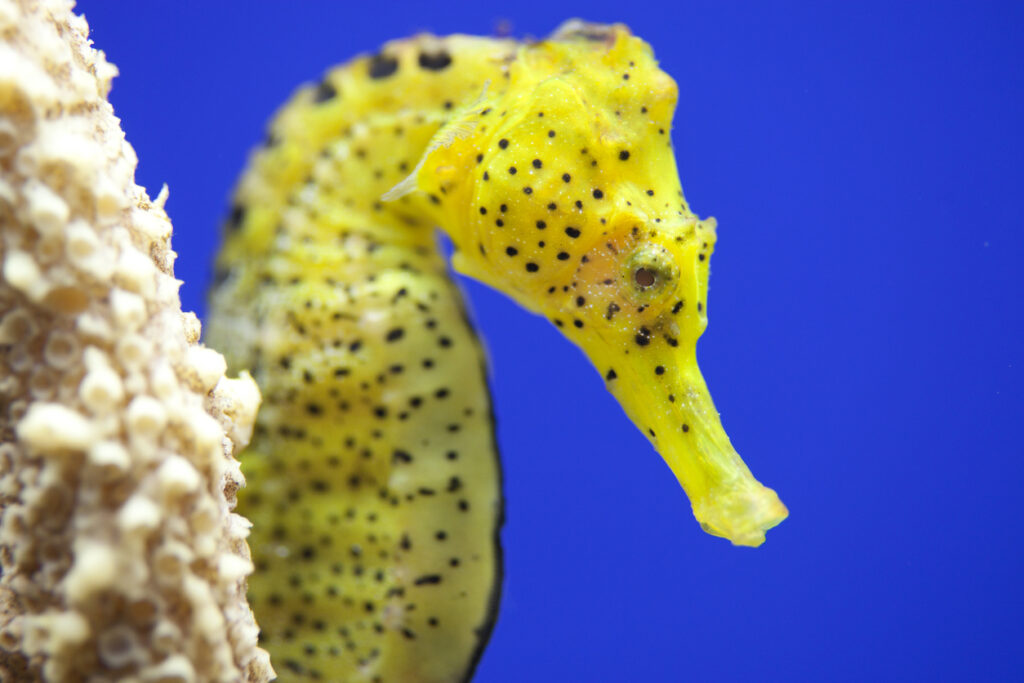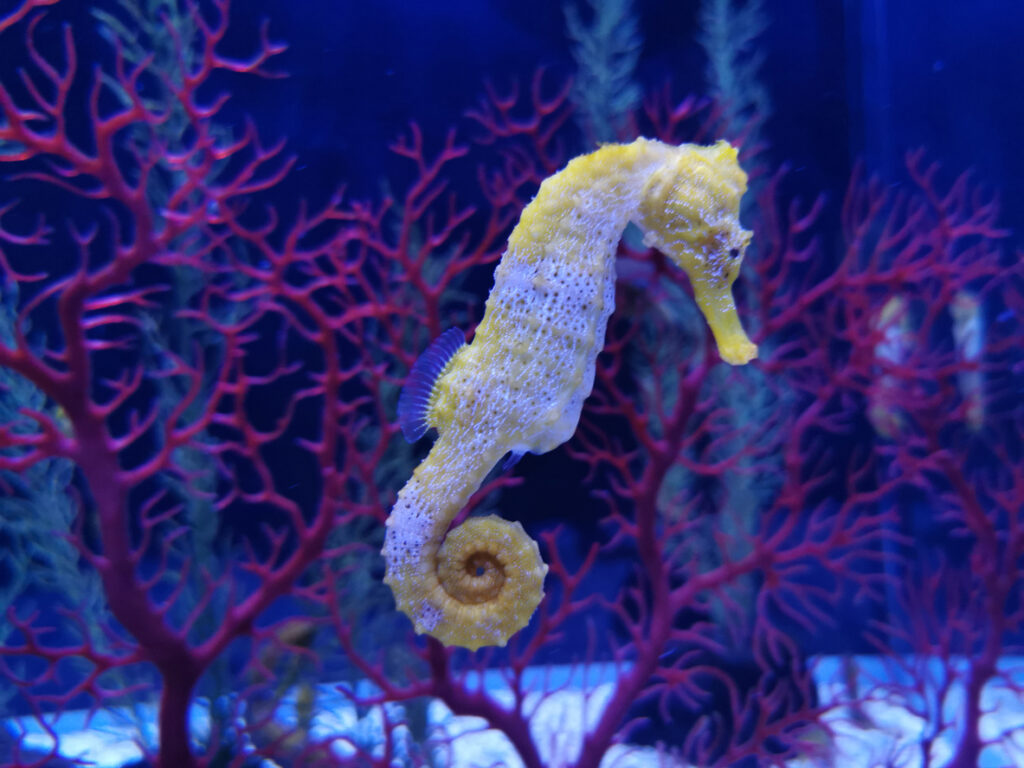Tiny and named after the shape of their head, seahorses are in fact still a fish, but they are incredibly different from any other fish out there! Found in both tropical and temperate waters around the world, the seahorse (Hippocampus) may breathe through gills and have a swim bladder like many other species, but their anatomy varies greatly from other sea creatures.
There are over 30 species of seahorse, and all are part of the Syngnathidae family, which makes seahorses close relatives to pipefish and seadragons – an exciting and unusual family of fish indeed!
So, why are seahorses so different? What is it about their anatomy that makes them stand out in an ocean full of beautiful marine life? Let’s find out!
What does a seahorse look like?
Seahorses often stand out against other sea inhabitants because they swim upright, not to mention their unique shape. The head is quite similar to that of a horse, while their tail is comparable to a monkey. It’s known as a prehensile tail, meaning it can hold on to things. While a monkey would use their tail to hang off branches, a seahorse uses theirs to grip holdfasts on the seafloor.
Seahorses also differ from other fish as they don’t have scales – instead, they have flesh-covered, bony plates that cover their whole body. They also have a dorsal (back) fin, which helps the seahorse to move forward through the water.
The other physical feature that helps a seahorse to stand out is its snout. Seahorses have long, thin snouts that point down, allowing them to suck food up – just like a hoover!

What are the different species of seahorse?
Most species of seahorse can fit into two categories: spiny or smooth. The spiny seahorses gain this name because they have sharp spines or spikes covering their bodies, but there are some species out there that don’t have these. With or without spines, seahorses have an appearance of wearing body armour which only adds to their unique look!
At Blue Reef Aquarium Portsmouth you will find the yellow seahorse (Hippocampus kuda), which is also known as the common seahorse. This type has no spines and can usually be found in the Indo-Pacific region.
The UK is home to two species of seahorses, the Spiny Seahorse (Hippocampus Guttulatus) and the Short-snouted Seahorse (Hippocampus hippocampus). Both of these can be found mainly down the west coast of the country, and all around Ireland!
Most seahorses live in sheltered and shallow waters such as seagrass beds, estuaries and coral reefs. Typically you would find seahorses in the West Atlantic and Indo-Pacific regions,
What’s so different about the male and female seahorses?
Probably the most obvious difference between seahorses and other fish is when it comes to reproduction. This situation is unique to seahorses and others in its Syngnathidae family, and is one of the most interesting facts about the species. It is the males that go through pregnancy, not the females!
The female seahorse will give her male partner the eggs, and he will carry them in a special pouch, like a kangaroo, to full term – which is only about two to four weeks. Depending on the species of seahorse, the male could give birth to a few dozen or over a thousand baby seahorses, which are known as seahorse fry. These tiny seahorse are only 7mm in length when born, and must fend for themselves from birth.
Only a male seahorse has a brood pouch, and you can use this when trying to tell the difference between a male and female.

Are seahorses endangered?
Seahorses face many of the same threats as other fish, such as habitat loss and climate change. However, many species of seahorses are under further threat because of their unique appearance and potential medicinal properties.
Millions of seahorses are taken from the ocean every year to be used in traditional Chinese medicine. It is said that seahorses can be used to cure asthma and heal skin infections, although there is no scientific evidence. What’s more, seahorses are also popular amongst the curio trade and are often sold as souvenirs in beach resorts.
With that in mind, some species of seahorses are more at risk than others. For example, the three-spot seahorse from the Indo-Pacific region has been listed as vulnerable, while the Cape seahorse from South Africa and White’s seahorse from Australia are both endangered.
Fun facts about seahorses
There’s still so much to discover about these unique creatures, so we’ve put together some more facts for you…
- Despite being a fish and living in the ocean, seahorses are actually poor swimmers. They use their dorsal fin to get around, with the additional help of small pectoral fins for stabilising and steering themselves. They need their dorsal fin to beat at 30-70 times per second to propel forwards, which means they spend a lot of time exhausted! It’s for this reason that seahorses typically live in shallow waters, and use their tail to cling on to vegetation or the seafloor.
- Seahorses may not be able to swim all that well, but they can do something else that’s very cool – they can change colour! Seahorses can camouflage themselves for a number of reasons, including hiding from predators and trying to attract a mate. Their skin has sack-like organs called chromatophores, and are controlled by the nervous system and hormones. Both males and females can change colour.
- Not only do seahorses have excellent eyesight, but their eyes can actually work independently from each other! This means they can move their eyes in different directions, similar to a chameleon. It’s a very handy skill as seahorses typically hunt for food using sight, so they have the ability to look forwards and backwards at the same time.
- Seahorses can’t chew, and don’t have a typical stomach. This means they have to use their snouts to eat almost continuously through the day! An adult seahorse will eat between 30-50 times per day, while seahorse fry eat around 3,000 pieces of food per day! Their meal of choice usually consists of plankton and small crustaceans.
Learnt something new? Why not come and see our Tropical Treasures exhibit at Blue Reef Aquarium Portsmouth and put your new knowledge into practice! Our tropical tanks are home to some of the most beautiful and colourful fish of the world. Check out our Visitor Info page for opening times and how to get here!
